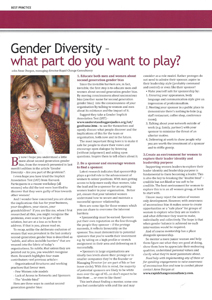Gender Diversity (Part 2) - What part do you want to play?
 Sunday, July 6, 2014 at 3:17PM
Sunday, July 6, 2014 at 3:17PM First published in Business First, July 2014
 By now I hope you understand a little more about second generation gender bias, from the research presented in last month’s edition in the article ‘Gender Diversity – Are you part of the problem?’.
By now I hope you understand a little more about second generation gender bias, from the research presented in last month’s edition in the article ‘Gender Diversity – Are you part of the problem?’.
I even hope you have tried the Implicit Association Test (IAT) from Harvard. Participants in a recent workshop (all women) who did the test were horrified to discover that they were guilty of bias towards other women!
And I wonder how concerned you are about the implications this has for your business, your daughters, your nieces, your grandchildren? If you are like me, when I first researched all this, you might recognise the problems, even want to be part of the solution, but are at a loss as to how to address. If that is you, please read on.
To recap, unlike the deliberate exclusion of women that was prevalent in the last century second-generation gender bias is described as “subtle, and often invisible barriers” that are weaved into the fabric of today’s organisations. So subtle, that unless they are pointed out to you, you wouldn’t recognise them. Research highlights four main contributors <ref previous article>:
- Organisational Structures and working practices that favour men.
- Few Women role models
- Lack of Access to Networks and Sponsors
- The “double bind”
Here are three ways to combat second generation gender bias:
Educate both men and women about second generation gender bias
Since the invisible barriers are, in fact, invisible, the first step is to educate men and women about second generation gender bias. By moving consciousness about unconscious bias (another name for second generation gender bias) into the consciousness of your organisation by talking to women and men about its existance and the impact of it.
Suggest they take a Gender Implicit Association Test (IAT) to see for themselves and openly discuss what people discover and the implications of this for the team or organisation, both now and in the future.
The most important thing here is to make it safe for people to share their views and encourage open dialogue by listening (without judgement) and asking open questions.
Inspire them to tell others about it.
Be a sponsor and encourage women to find a sponsor.
Latest research indicates that sponsorship plays a pivitol role in the advancement of women to senior positions. With men getting access to help more easily than women, take the lead and be a sponsor for an aspiring women leader in your organisation. Better yet, ensure that your talented women understand how to secure and maintain a successful sponsor relationship. Here are some tips for those women which you can share to overcome the inherent barriers:
- Sponsorship must be earned. Sponsors put their own reputation on the line through the people they sponsor – if the protege succeeds, it reflects favourably on the sponsor. You must demonstrate to potential sponsors that you’re worth their investment e.g. by taking on a high profile or stretch assignment in their area and delivering on it successfully.
- Sponsors in large organisations are ideally two levels above their protege or in smaller companies they’re the founder or Managing Director (or are part of his or her inner circle). With this in mind, the majority of potential sponsors are likely to be white men over the age of 45...so don’t expect to be like them …. or even to like them! This isn’t about finding a mentor, some-one you feel comfortable with and like and may consider as a role mode. Rather proteges do not need to admire their sponsor, aspire to their leadership style (probably command and control) or even like their sponsor!
- Make yourself safe for sponsorship by:
- Ensuring your appearance, body language and communication style give an impression of professionalism.
- Meeting your sponsor in a public place to demonstrate there’s nothing to hide (e.g. staff restaurant, coffee shop, conference room).
- Talking about your network outside of work (e.g. family, partner) with your sponsor to minimise the threat of an ulterior motive.
- Delivering at work to show people why you are worth the investment of a sponsor and to stiffle gossip.
Create an environment for women to explore their leader identity and leadership purpose
Supporting women leaders to explore their leader identity and leadership purpose is fundamental to them becoming a leader. This is also the key to breaking the “double bind” – credible but not liked or too soft to be credible. The best environment for women to explore this is in an all women group, at least to start with.
I know many reject the notion of women only development. However, with awareness of unconscious bias it makes sense to create opportunities or a “safe place” for groups of women to explore who they are as leaders and what difference they want to make, individually and collectively. The hope is that when gender balance is achieved no such intervention would be required.
And of course mentorship has a place alongside sponsorship. So mentor a more junior woman and help them figure out what they are good at doing, show them how to appreciate their endearing qualities, understand personal values and clarify what they’re most passionate about.
If you need help with implementing any of these, or for speaking engagements to raise awareness of Unconscious Bias and how to combat, please contact Anne Dargan at anne@rapidchangeconsultancy.com or 07711 599091.

Reader Comments